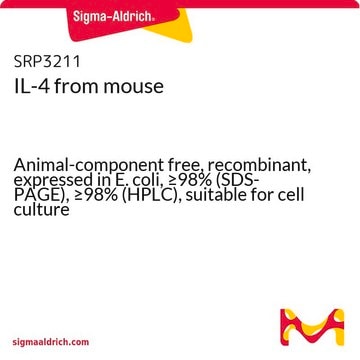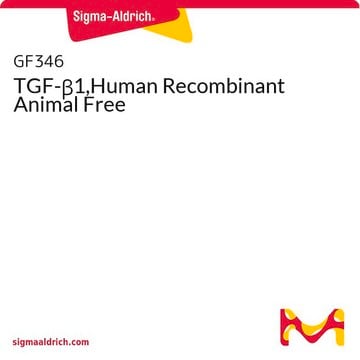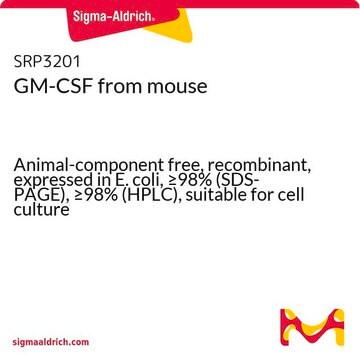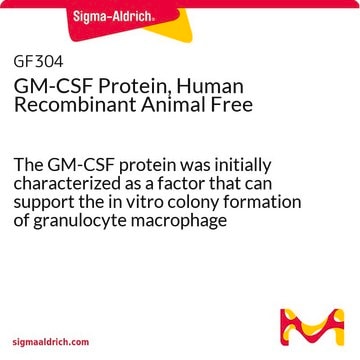GF348
TWEAK,
Human Recombinant Animal Free
Sinônimo(s):
TNFSF12, MGC129581, DR3LG, TWEAK, APO3L
Faça loginpara ver os preços organizacionais e de contrato
About This Item
Código UNSPSC:
12352202
eCl@ss:
32160405
NACRES:
NA.77
Produtos recomendados
Categorias relacionadas
Descrição geral
Product Source: Protein is expressed in E.coli.
The protein is manufactured without the use of any animal products/reagents and is considered Animal-Free and can be used in protocols where possible transmisson of animal viruses and contamination must be avoided.
The protein is manufactured without the use of any animal products/reagents and is considered Animal-Free and can be used in protocols where possible transmisson of animal viruses and contamination must be avoided.
TWEAK belongs to the TNF family of ligands and signals through TWEAKR also known as TNFRSF12A. TWEAK is expressed in a variety of tissues, including the adult heart, pancreas, skeletal muscle, small intestine, spleen and peripheral blood lymphocytes. TWEAK has the ability to induce NFkB activation and chemokine secretion, and to exert an apoptotic activity in certain cells, such as HT-29 human adenocarcinoma cells when cultured in the presence of IFN-. TWEAK also promotes proliferation and migration of endothelial cells.
Recombinant human TWEAK is a soluble 17.0 kDa polypeptide (154 amino acid residues) comprising the TNF homologous region of TWEAK and is generated by proteolytic processing of the full length membrane anchored TWEAK protein.
Recombinant human TWEAK is a soluble 17.0 kDa polypeptide (154 amino acid residues) comprising the TNF homologous region of TWEAK and is generated by proteolytic processing of the full length membrane anchored TWEAK protein.
Aplicação
Research Category
Stem Cell Research
Stem Cell Research
Research Sub Category
Growth Factors & Receptors
Growth Factors & Receptors
Qualidade
Assay #1: The ED50 as determined by the dose-dependent stimulation of IL-8 production by human PBMC is less than 10 ng/ml.
Assay #2: TWEAK weakly induces the death of HT29 cells when cultured in the presence of IFN-γ. The ED50 for this effect is between 30-45 ng/ml.
Assay #2: TWEAK weakly induces the death of HT29 cells when cultured in the presence of IFN-γ. The ED50 for this effect is between 30-45 ng/ml.
forma física
Product is presented in 10 mM Sodium Phosphate, pH 7.5 + 80
mM L-Arginine and is filtered through a 0.2 micron filter before lyophilization.
mM L-Arginine and is filtered through a 0.2 micron filter before lyophilization.
Armazenamento e estabilidade
Store at -20°C for up to 4 months from date of receipt Centrifuge the vial prior to opening.
Reconstitute in water to a concentration of 0.1-1.0 mg/ml. Do not vortex. For extended storage, it is recommended to further dilute in a buffer containing a carrier protein and store in working aliquots at -20°C.
Reconstitute in water to a concentration of 0.1-1.0 mg/ml. Do not vortex. For extended storage, it is recommended to further dilute in a buffer containing a carrier protein and store in working aliquots at -20°C.
Exoneração de responsabilidade
Unless otherwise stated in our catalog or other company documentation accompanying the product(s), our products are intended for research use only and are not to be used for any other purpose, which includes but is not limited to, unauthorized commercial uses, in vitro diagnostic uses, ex vivo or in vivo therapeutic uses or any type of consumption or application to humans or animals.
Código de classe de armazenamento
11 - Combustible Solids
Classe de risco de água (WGK)
WGK 1
Certificados de análise (COA)
Busque Certificados de análise (COA) digitando o Número do Lote do produto. Os números de lote e remessa podem ser encontrados no rótulo de um produto após a palavra “Lot” ou “Batch”.
Já possui este produto?
Encontre a documentação dos produtos que você adquiriu recentemente na biblioteca de documentos.
Nossa equipe de cientistas tem experiência em todas as áreas de pesquisa, incluindo Life Sciences, ciência de materiais, síntese química, cromatografia, química analítica e muitas outras.
Entre em contato com a assistência técnica








